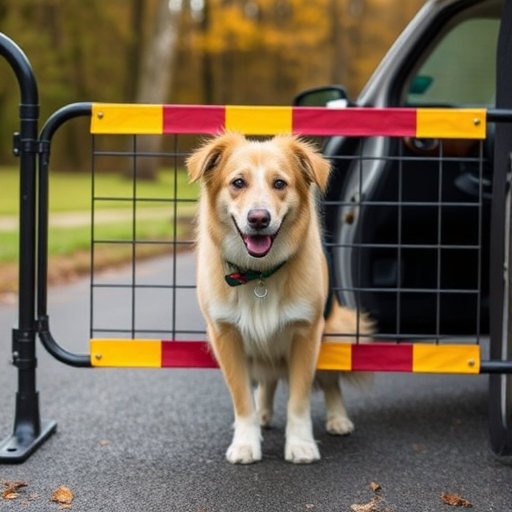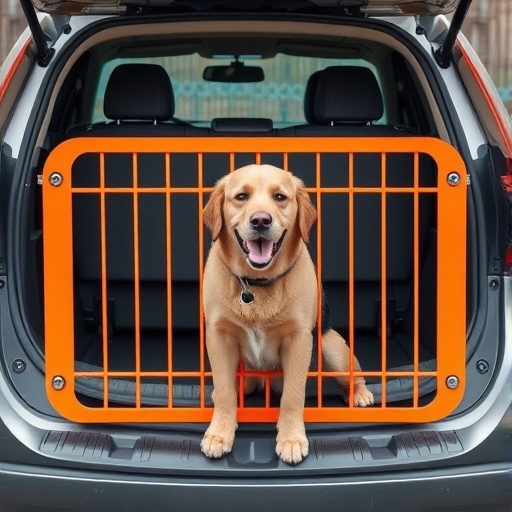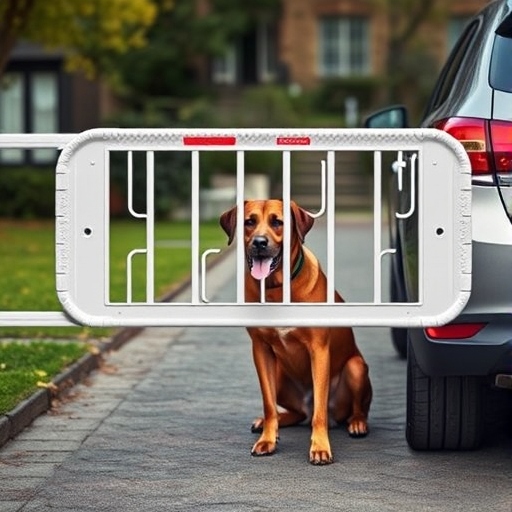A dog barrier for a car is a partition that helps to keep your dog safely confined in a specific area of your vehicle, preventing them from distracting you while you are driving. What you need to know:
Types of Dog Barriers

- Universal Barriers: These are designed to fit most vehicles and typically attach to the headrests or cargo area. They are often made of metal or mesh.
- Custom Barriers: These are made to fit the specific make and model of your vehicle for a more secure and tailored fit. They are often more expensive than universal barriers.
- Cargo Barriers: These are designed to keep your dog in the cargo area of an SUV or hatchback.
- Seat Barriers: These can be soft or hard and are designed to keep your dog off the front seat.
Benefits of Using a Dog Barrier
- Reduces Driver Distraction: A barrier keeps your dog from moving around the car, climbing into the front seat, or otherwise distracting you while driving. In the event of a sudden stop or accident, a barrier can help prevent your dog from being thrown around the vehicle and potentially injured.
- Protects Your Car’s Interior: A barrier can help prevent your dog from scratching, chewing, or shedding on your car’s seats and upholstery.
How to Choose the Right Dog Barrier:
Consider your vehicle: Measure the space where you want to place the barrier to ensure a proper fit.
- Consider your dog: If you have a large or active dog, you’ll need a stronger barrier.
- Consider your needs: Do you need a barrier that’s easy to install and remove? Do you need a barrier that’s adjustable?
Where to Buy Dog Barriers
Dog barriers are widely available at pet stores, big box stores, and online retailers.
Remember, it is important to choose a dog barrier that is appropriate for your vehicle and your dog’s size and temperament. By using a dog barrier, you can help ensure a safer and more enjoyable car ride for both you and your furry friend.
How to Choose the Best Dog Barrier for Your Car
A dog barrier for your car is a great way to keep your furry friend safe and secure while you’re on the go. Here is a guide on how to choose the best barrier for your dog. They usually attach to the headrests or the roof of your car.
Mesh Barriers: These are lighter and more affordable than metal barriers. They usually attach to the headrests and can be a good option for smaller dogs or dogs who are less likely to try to jump over the barrier.
Hammock Barriers: These not only keep your dog in the back seat but also protect your seats from dirt, scratches, and hair. They usually attach to the front and rear headrests.
Between-Seat Barriers: These are designed to block the gap between the front seats, preventing your dog from climbing into the front. They can be a good option for smaller dogs or as an additional barrier in combination with another type.
Factors to Consider:
Size of your dog: If you have a larger dog, you’ll need a more robust barrier like a metal one. For smaller dogs, a mesh or between-seat barrier might suffice.
Size and type of your car: Measure the space in your car where you plan to install the barrier to ensure a good fit. Some barriers are adjustable, but it’s still important to check the dimensions.
Your dog’s behavior: If your dog is a known jumper or climber, you’ll need a taller and stronger barrier.
Ease of installation: Consider how easy the barrier is to install and remove. Some barriers require tools, while others can be installed quickly without any tools.
Additional features Some barriers come with extra features like pockets for storage or a padded surface for your dog to rest on.
Recommendations:
- Best Metal Dog Barrier: PetSafe Deluxe Happy Ride Dog Barrier
- Best Hammock Dog Barrier: Frisco Quilted Water-Resistant Hammock
- Best Between-Seat Dog Barrier: Dykeson Pet Barrier
- Best Mesh Dog Barrier: Starroad-Time Car Dog Barrier
Ultimately, the best dog barrier for your car will depend on your individual needs and preferences. Consider the factors listed above and choose the barrier that you feel will best keep your dog safe and secure while you’re on the road.
Top Benefits of Using a Dog Barrier in Your Vehicle
A dog barrier is a great way to keep your dog safe and secure while you’re driving. Here are some of the benefits of using one:

Reduces driver distraction: A dog roaming freely in a car can be a major distraction, leading to accidents. A barrier keeps your dog in a designated area, allowing you to focus on the road.
Protects your dog in case of sudden stops or accidents: In the event of a sudden stop or collision, a barrier prevents your dog from being thrown around the vehicle, potentially causing serious injuries.
Prevents your dog from interfering with vehicle controls: A curious dog might try to climb into the front seat or even step on the pedals, creating a dangerous situation. A barrier keeps them safely away from these areas.
Keeps your dog from getting into things they shouldn’t do: If your dog is prone to chewing or getting into things, a barrier can prevent them from damaging your car’s interior or your belongings.
Provides a safe and comfortable space for your dog: A barrier can create a den-like space for your dog, helping them to feel more secure and relaxed during car rides.
Overall, a dog barrier is a worthwhile investment for any dog owner who travels with their pet. It can help to keep both you and your dog safe and comfortable on the road.
Dog Barriers vs. Dog Seat Belts: What’s Better?
The best way to restrain a dog in a car is with a combination of a dog seat belt and a dog barrier. A dog seat belt will keep your dog from moving around in the car and potentially distracting you while you’re driving. A dog barrier will keep your dog from climbing into the front seat and interfering with your ability to drive.
Dog seat belts are typically made of nylon or mesh and attach to your dog’s harness or collar. They can be used in the front or back seat of your car. Dog barriers are typically made of metal or plastic and can be installed in the front or back of your car.
Here are some of the benefits of using a dog seat belt:
Keeps your dog safe in the event of a car accident
Prevents your dog from distracting you while you’re driving
Keeps your dog from climbing into the front seat
Prevents your dog from being thrown from the car in the event of a sudden stop
Here are some of the benefits of using a dog seat belt:
Keeps your dog from climbing into the front seat
Prevents your dog from interfering with your ability If you’re not sure which method is right for you, talk to your veterinarian or a professional dog trainer.
In addition to using a dog seat belt or dog barrier, you can also take other steps to keep your dog safe in the car. For example, you can make sure that your dog is properly hydrated and has access to food and water. You can also take breaks every few hours to let your dog out for a potty break and some exercise.
Easy Steps to Install Your Dog Barrier in Any Car
It’s awesome you’re looking into a dog barrier for your car! It’s a great way to keep everyone safe and comfortable while driving. Here’s a general guide to installing most types of barriers, but remember to always check the specific instructions that come with your chosen product.

Types of Barriers
- Net Barriers: These are usually the easiest to install, attaching to headrests with hooks or straps.
- Rigid Barriers: These offer more stability and are often adjustable to fit different vehicles. They might require pressure mounting or attaching to cargo hooks.
- Seat Barriers: These create a barrier between the front and back seats. Installation varies but often involves straps around the headrests and seat backs.
General Installation Steps
1. Choose the Right Barrier: Consider your dog’s size, your car’s make and model, and the type of barrier that best suits your needs.
2. Gather your tools. You may need a screwdriver, measuring tape, and possibly a wrench, depending on the type of barrier.
3. Read the Instructions: Seriously, this is the most important step! Each barrier differs in some way.
4. Position the Barrier: For cargo barriers, place it behind the back seats or in the cargo area, ensuring it fits snugly.
For seat barriers, position them between the front and back seats.
5. Attach the Barrier
Pressure Mounted: Extend the barrier so that it fits snugly between the floor and roof of your car.
Straps and Hooks: Attach straps to headrests or cargo hooks as directed.
Bolts: If your barrier requires drilling, follow the instructions carefully and make sure it is securely attached.
6. Double-Check Stability: Give the barrier a good shake to ensure it’s securely in place and won’t move around while driving.
7. Introducing Your Dog: Let your dog sniff and explore the barrier before your first drive. Start with short trips to help them adjust.
Important Safety Tip
Never install a barrier that blocks the driver’s view.
Ensure the barrier is strong enough to contain your dog in case of sudden stops.
Regularly check the barrier for any signs of wear and tear.
If your barrier uses pressure mounting, check the fit periodically, especially in hot weather.
By following these steps and the manufacturer’s instructions, you can easily install your dog barrier and ensure safe and enjoyable car rides for you and your pet.
Common Mistakes When Using a Dog Barrier in Your Car
When using a dog barrier in your car, some common mistakes can compromise its effectiveness and your dog’s safety. Here are a few to avoid:
- Choosing the wrong type of barrier: Not all barriers are created equal. Some are designed for specific vehicles or dog sizes. Make sure the barrier you choose is appropriate for your car and your dog’s breed and size. A poorly installed barrier is just as bad as no barrier at all. Follow the manufacturer’s instructions carefully and ensure the barrier is securely in place.
- Ignoring the dog’s behavior: Some dogs may try to climb over or chew through the barrier. If your dog exhibits this behavior, you may need to choose a different type of barrier or use additional training to discourage them.
- Using a barrier as the sole restraint: While a barrier can keep your dog in the back of the car, it won’t protect them in a crash. For maximum safety, use a dog harness or carrier in addition to the barrier. Remember, the goal is to keep both you and your dog safe while driving.
By avoiding these common mistakes, you can ensure that your dog barrier is used effectively.
How a Dog Barrier Can Make Car Rides Safer
A dog barrier can significantly improve safety during car rides for both you and your furry friend. This is how:

Prevents driver distraction: An unrestrained dog can move around the car, possibly jumping into the front seat, interfering with the driver’s ability to steer or brake, or even obstructing their view. A barrier keeps the dog confined to the back seat or cargo area, allowing the driver to focus on the road.
Protects the dog in case of sudden stops or accidents: In the event of a sudden stop or collision, an unrestrained dog can be thrown around the vehicle, causing serious injuries to themselves and potentially to human passengers as well. A barrier helps to contain the dog, reducing the risk of such injuries.
Reduces anxiety for both dog and driver: Some dogs get anxious during car rides, pacing, whining, or barking. By providing a secure and defined space, a barrier can help reduce their anxiety. This, in turn, makes for a less stressful and safer driving experience for the owner.
While a dog barrier is a good tool, it’s most effective when used in conjunction with other safety measures.
Proper barrier installation: A poorly installed barrier can fail in an accident. Always follow the manufacturer’s instructions carefully.
By properly using a dog barrier and combining it with other safety measures, you can create a much safer environment for both you and your dog during car travel.

